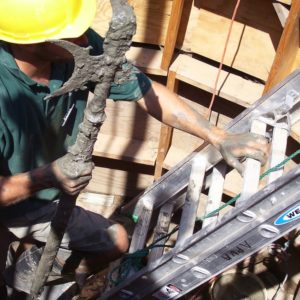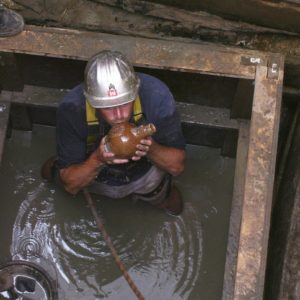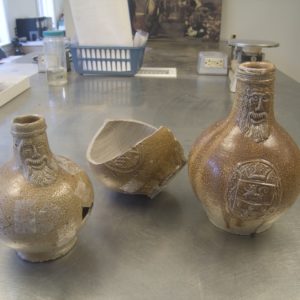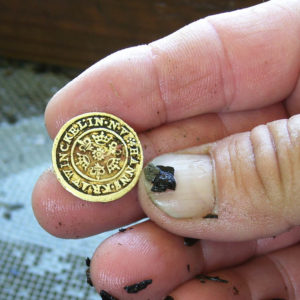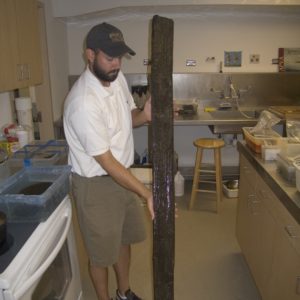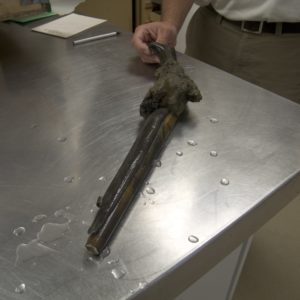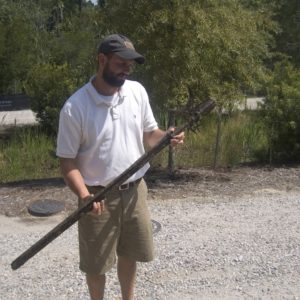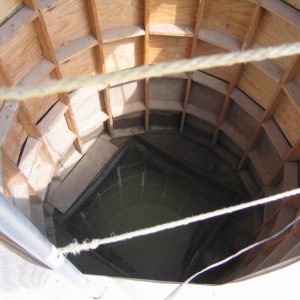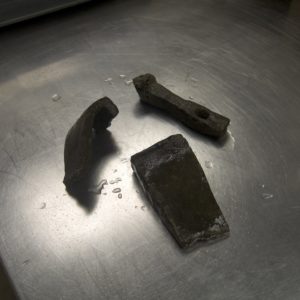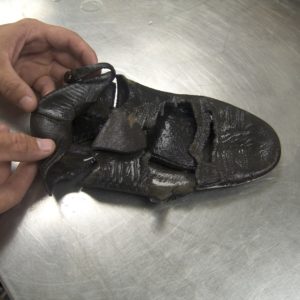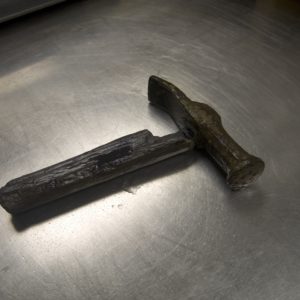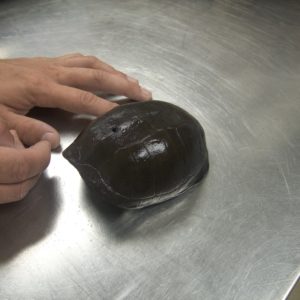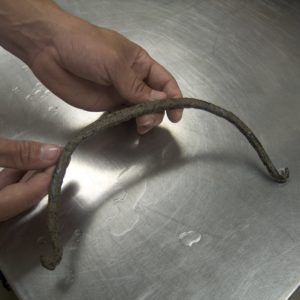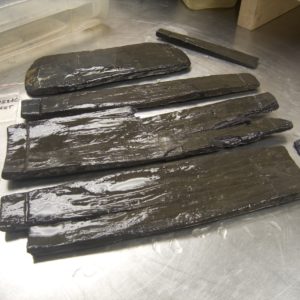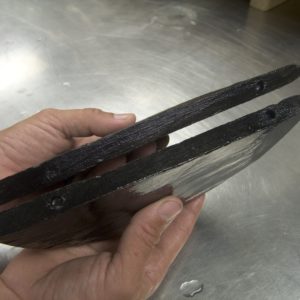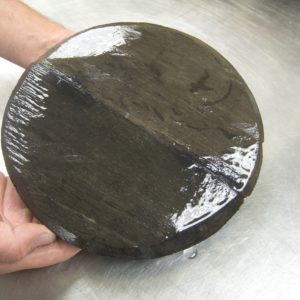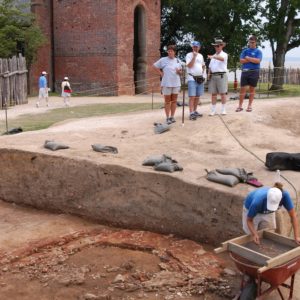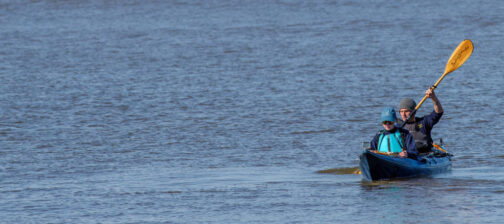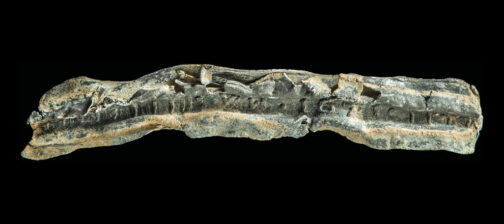Jamestown Rediscovery archaeologists have reached undisturbed soil in an early 17th century well discovered inside the northern corner of James Fort. The fact that the soil is undisturbed indicates that they have finally reached the bottom of the well. Finds including a halberd, a Scottish pistol, several Bartmann jugs and an ornate leather shoe have made excavating the last few feet of the well an experience of almost constant discovery.
Being underwater for the last 400 years meant survival and extraordinary preservation for these artifacts, some of which would not have survived had they instead been exposed to the elements above. Leather and wooden objects have been excavated from the well, the discovery of which is a rarity in a typical earthern environment. The key to these remarkable finds is the fact that their watery tomb has shielded them from exposure to the air above for the last four centuries. Where metal objects are usually rusted over when excavated, sometimes beyond recognition, those in the well below the water table are practically free of rust and other forms of corrosion.
A beautifully preserved halberd has been found in the well. Half of the wooden staff is intact and is still attached to the blade by thin metal straps called languets. While they could still be used as weapons, halberds in the early 17th century were primarily parade arms carried by body guards to important people. The intricate open-work on the halberd blade from the well includes the heads of two griffins. The griffin head was the family crest of the De La Warr family. Sir Thomas West, the 12th Baron De La Warr, arrived at Jamestown on June 10, 1610 and this halberd was likely carried by one of his soldiers. The fact that the halberd was found in the well is evidence that the well was either in use as a water source or as a trashpit at that time. At some point prior to 1616/17, the well was filled in and probably forgotten about because a brick hearth of a substantial building was built on top of the well shaft. This building, which had a cobblestone foundation, was an addition to a structure begun in 1611 as the governor’s house. The halberd’s blade is in remarkable shape as is its wooden pole, complete with iron structural reinforcements.
Other finds from the well include a 17th-century Scottish pistol with its bronze barrel and wooden stock, two nearly intact Bartmann jugs, and a small lead plaque, reading “Yames Towne.” The equivalent of a modern-day luggage tag, the plaque was probably marking some merchandise that had been warehoused in London before being shipped out to Jamestown. The odd “Y” spelling may suggest a German or Dutch origin for the goods as those languages represented “j”s with “y”s during this time period.
A leather shoe, remarkable in its completeness and condition, and adorned with fine detailing, was another of the finds. Parts of other shoes were found as well, including a sole that had been repaired with a piece of another sole. The well bucket itself was found, though in various pieces. The bucket bottom, side wall pieces, and handle were excavated, as well as an iron chain which may have been used to raise and lower the bucket. Other artifacts discovered in the well include a nearly intact hammer, a turtle shell, a rapier hilt, and an iron pike head with its languets and part of its wooden staff. Like the halberd, the pike head appears to have been bent into a hook, perhaps to fetch something dropped in the well. Part of an axe blade, another hammer and an iron wedge were also found. Along with these man-made objects, leaves, seeds, and even insects were discovered in the bottom of the well—things that may be able to give us insight into the environment in which the colonists and Native Americans lived.
The archaeologists are excavating areas just to the south of the well at this time. A cellar found underneath the 1617-1618 extension to the 1611 governor’s house is yielding several early artifacts including many Native American items. These may be an indication of pre-colonial habitation of the island by Native Americans. Another very interesting feature currently being excavated is the foundation to a bay window on the east wall of the governor’s house. The bay window was also part of the 1617-1618 extension. At the time the extension was built, James Fort had been expanded to become a five-sided structure.
related images
- Shading the well for the archaeologists below
- Halberd removed from well
- Bartmann jug seconds after being removed from the well water
- Bartmann jugs from well
- Jetton from well
- Part of original wooden well frame
- Pistol from well
- Scottish or Italian style pistol
- Senior conservator Michael Lavin with Lord De La Warr halberd
- The well water now visible, the archaeologists have to pump it out to dig
- Part of an axe blade(left), hammer(top right), and wedge(bottom)
- Ornate shoe, one of fifteen shoes found in the water logged layers of the well
- Hammer
- Pike head (bent into hook shape) and the languets used to attach the head to the wooden staff
- Rapier hilt to a sword
- Turtle shell
- Chain, possibly used to raise and lower bucket
- Bucket handle
- Well bucket walls
- Bottom of well bucket with peg holes
- Bottom of well bucket
- Excavation of the bay window




